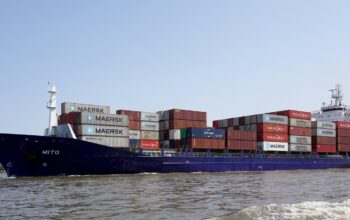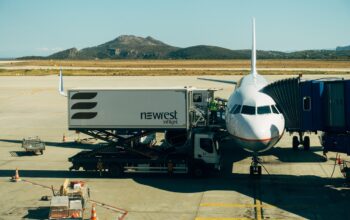The Supply Chain Rollercoaster in 2025
Picture this: global supply chains like massive trains—complex, interconnected, and constantly in motion. In 2025, these trains are speeding through a tunnel of drama fueled by rising tariffs, AI tech breakthroughs, and booming consumer demands for transparency. Let’s unpack the stories shaking up the world’s supply networks.
Tech Takes Over: AI and Automation Accelerate
Companies are racing to embed artificial intelligence into their supply chains faster than ever. This year, a whopping majority of technology vendors report double-digit growth in sales as more businesses invest in automating logistics tasks. AI isn’t a buzzword anymore; it’s the conductor helping the supply chain train run smoother.
Greg Kefer, a marketing expert in AI logistics platforms, notes the transformative power of AI to “read” and interpret data from partners without human handoffs—imagine shipping paperwork processed in seconds not days. This innovation is breaking down old-school habits of juggling emails and spreadsheets and is revolutionizing how freight moves worldwide.
For suppliers and shippers dealing with labor shortages and rising costs, automated logistics is a life-saving innovation that increases efficiency without sacrificing service quality.
Tariffs Stir Up Trade Tensions and Inventory Chaos
Global trade tensions remain front and center in 2025, with the U.S. persisting in its high tariff strategies that echo policies first seen in the previous administration. The latest round of tariffs—especially on semiconductors and automobiles—has injected uncertainty into supply chains.
Semiconductor imports, vital for everything from cars to smartphones, are under scrutiny following national security investigations. This has rattled manufacturers, especially those relying on cross-border production hubs like Mexico.
Tariffs have caused companies to rethink their entire supply strategies—some stockpile inventory, others seek overflow warehouse space. Logistic giants report a surge in demand for temporary storage solutions as businesses brace for unpredictable shipping costs and delays.
Adam Miller, CEO of a leading trucking company, says these tariff worries are chilling shipment volumes, with customers wary of rising costs but still needing to meet consumer demand.
Transparency: The New Supply Chain Currency
There’s a growing call for see-through supply chains, driven by consumers wanting to know exactly where their products come from and how they’re made.
Blockchain, once the flashy tech darling, is maturing into a practical tool for traceability. Over half of companies believe blockchain will soon be central to transparent supply chains. It’s a game changer for industries like food and beverage, where tracking a contaminated batch quickly can prevent major health crises and costly recalls.
Retailers, burdened by tightened regulations and consumer expectations, are pushing for verified, site-level data from suppliers. Self-assessments provide a start, but trusted third-party audits bring the credibility buyers and governments demand.
Technology like cloud-based labeling systems helps connect different trading partners, ensuring that every product’s journey is mapped and mistakes minimized.
Practical Takeaways for Businesses and Consumers
-
Invest in tech: Automation and AI aren’t just futuristic luxuries; they help navigate complexity and shortages.
-
Stay alert to tariffs: Trade policies can reshape costs and lead times overnight; agile inventory planning is key.
-
Demand transparency: Brands that show clear supply chain visibility boost consumer trust and protect their reputation.
In Summary
The supply chain story in 2025 is a drama of innovation clashing with geopolitical pressures. Companies embracing new technologies and transparent practices are better equipped to soften the blow of tariffs, labor shortages, and rising consumer expectations. Meanwhile, the nervous shuffle of businesses adjusting to these changes reminds us all that in global logistics, the only constant is change.
Like a complex play with multiple acts, 2025’s supply chain scene will continue to unfold with new technology cues, trade policy plot twists, and consumer demand as the ultimate director.
From warehouses doubling up for inventory surges to AI transforming customs paperwork, this year’s supply chain challenges are dramatic but full of opportunity for those ready to adapt.
References:
- https://www.inboundlogistics.com/articles/2025-il-market-research-whats-happening-in-supply-chain-and-logistics-technology/
- https://www.supplychaindive.com
- https://talkinglogistics.com/2025/04/25/above-the-fold-supply-chain-logistics-news-april-25-2025/
- https://www.supplychain247.com/article/top_5_supply_chain_visibility_trends_for_2025_embracing_transparency_and_traceability
- https://www.sedex.com/blog/retail-trends-supply-chain-due-diligence-2025/
- https://www.louisburg.edu/academics/college-catalog/2024-2025_CollegeCatalog_LouisburgCollege_4.23.25.pdf
- https://www.ismworld.org/supply-management-news-and-reports/news-publications/inside-supply-management-magazine/blog/2025/2025-04/how-tariffs-could-disrupt-semiconductor-supply-chains/
- https://www.hazelparkschools.org/downloads/_news_/hazel_park_schools_-_agenda_for_regular_meeting.pdf.pdf



